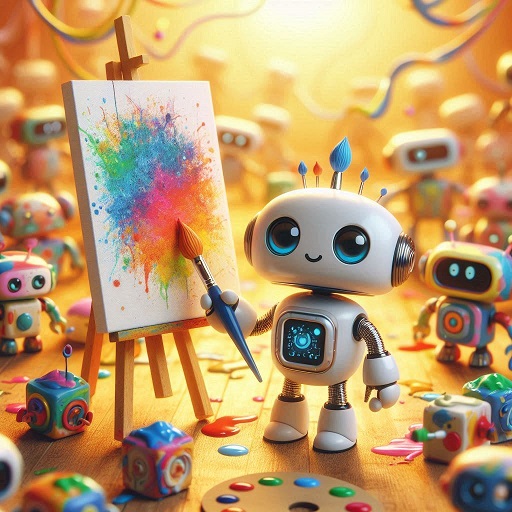The painting robot industry, an integral part of the automation and robotics sector, is poised for significant growth and transformation. Painting robots are increasingly used across various industries due to their efficiency, precision, and consistency.
As the technology evolves, the landscape of the painting robot industry is expected to shift in response to emerging trends, market dynamics, and technological advancements.
This article delves into the future of the painting robot industry, exploring trends, growth prospects, market size, key players, regional analysis, and segmentation.

Trends Shaping the Painting Robot Industry
- Advancements in Robotics and AI: The integration of artificial intelligence (AI) and machine learning into painting robots enhances their capabilities, enabling them to adapt to different surfaces, paint types, and environmental conditions. These advancements lead to more accurate and efficient painting processes.
- Customization and Flexibility: Modern painting robots are designed to be highly customizable, allowing for adjustments in painting parameters based on specific requirements. This flexibility caters to a broader range of applications, from automotive to aerospace industries.
- Increased Demand for Automation: The shift towards automation in manufacturing processes is driving the adoption of painting robots. Industries are seeking ways to improve productivity, reduce labor costs, and achieve consistent quality, which painting robots provide.
- Focus on Sustainability: With growing environmental concerns, the painting robot industry is focusing on sustainable practices. Innovations include the use of eco-friendly paints and reduced material wastage, aligning with global sustainability goals.
- Integration with Industry 4.0: The adoption of Industry 4.0 technologies, including the Internet of Things (IoT) and smart manufacturing, is enhancing the capabilities of painting robots. These technologies enable real-time monitoring, predictive maintenance, and seamless integration with other automated systems.
Painting Robot Market Growth and Size
The painting robot industry has experienced steady growth over the past few years, driven by increased automation in various sectors. According to market research, the industry is projected to continue its upward trajectory, The global painting robot market size is estimated to be USD 3.1 billion in 2024 and is projected to reach USD 5.8 billion by 2029, registering a CAGR of 13.1% during the forecast period.
This growth is attributed to rising industrial automation, advancements in robotics technology, and the need for improved efficiency in painting processes.
Painting Robot Industry Share and Top Companies
The painting robot industry is characterized by the presence of several key players who dominate the industry. Major companies include:
- Fanuc Corporation: Known for its advanced industrial robots, Fanuc offers a range of painting robots with high precision and reliability.
- KUKA AG: KUKA provides versatile painting robots designed for various applications, including automotive and aerospace industries.
- ABB Ltd.: ABB’s painting robots are renowned for their flexibility and integration with automation systems.
- Yaskawa Electric Corporation: Yaskawa offers a range of painting robots with cutting-edge technology and customizable features.
- Dürr AG: Specializing in painting and coating systems, Dürr provides innovative solutions for the automotive and industrial sectors.
Painting Robot Industry – Regional Analysis
- North America: The North American market is a significant contributor to the painting robot industry, driven by advanced manufacturing technologies and high adoption rates in automotive and aerospace industries. The United States and Canada are major markets, with a focus on integrating AI and Industry 4.0 technologies.
- Europe: Europe is a key region for the painting robot industry, with strong demand in automotive, aerospace, and industrial sectors. Countries like Germany, France, and the UK are leading in the adoption of advanced painting robots.
- Asia-Pacific: The Asia-Pacific region is witnessing rapid growth in the painting robot industry due to expanding manufacturing sectors in countries like China, Japan, and South Korea. The region is also experiencing a surge in automotive and electronics industries, driving the demand for painting robots.
- Latin America: Latin America is emerging as a growing market for painting robots, with increasing industrialization and investments in automation technologies.
- Middle East and Africa: The Middle East and Africa are witnessing gradual growth in the painting robot industry, driven by infrastructure development and industrial expansion.
Painting Robot Industry Opportunities and Challenges
Opportunities:
- Emerging Markets: The growth of manufacturing industries in emerging markets presents opportunities for the expansion of painting robots.
- Technological Advancements: Continuous advancements in robotics technology and AI offer opportunities for innovation and enhanced capabilities.
- Customization and Integration: There is a growing demand for customizable painting robots that can be integrated with existing automation systems.
Challenges:
- High Initial Costs: The initial investment in painting robots and associated infrastructure can be a barrier for small and medium-sized enterprises.
- Skill Gaps: The need for skilled personnel to operate and maintain advanced painting robots poses a challenge.
- Technological Complexity: The integration of new technologies and keeping up with rapid advancements can be challenging for manufacturers.
Segmentation by Mounting Type and Robot Type
- Mounting Type:
- Floor-Mounted Robots: These robots are commonly used in manufacturing environments where stability and precision are essential.
- Wall-Mounted Robots: Wall-mounted robots offer flexibility in painting large surfaces and are often used in automotive and aerospace industries.
- Ceiling-Mounted Robots: Ceiling-mounted robots are ideal for space optimization and are used in applications where floor space is limited.
- Robot Type:
- Articulated Robots: These robots offer a wide range of motion and are used in various painting applications due to their flexibility and precision.
- SCARA Robots: Selective Compliance Assembly Robot Arm (SCARA) robots are used for high-speed painting applications where precision is crucial.
- Delta Robots: Delta robots are known for their speed and are used in applications requiring rapid and accurate painting processes.
